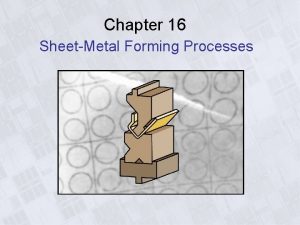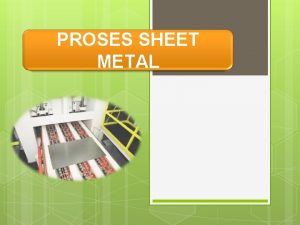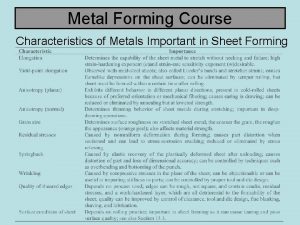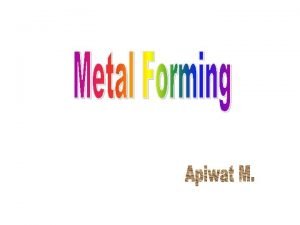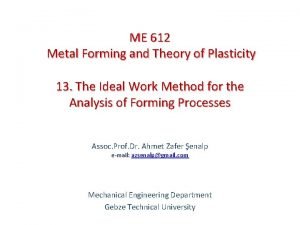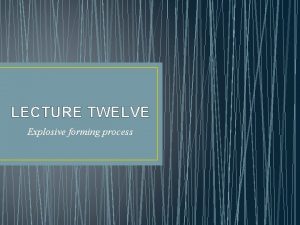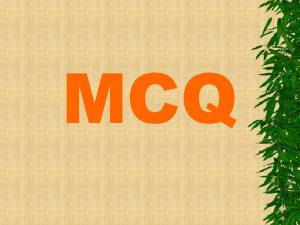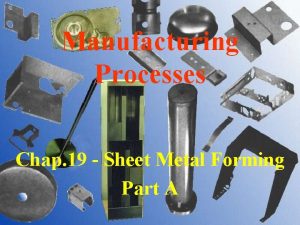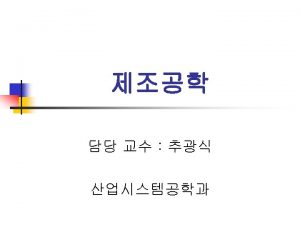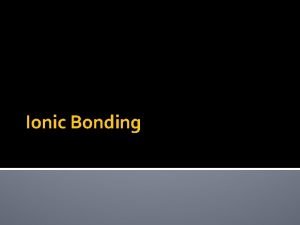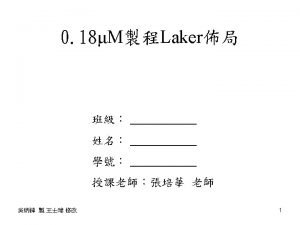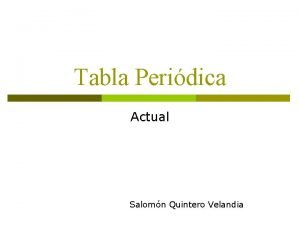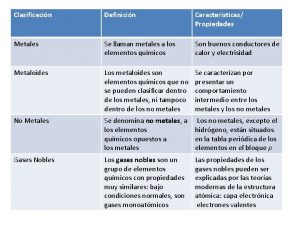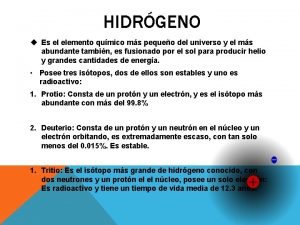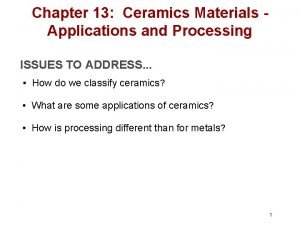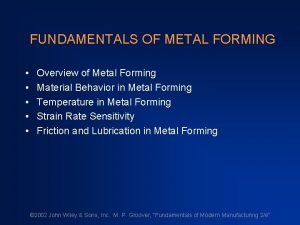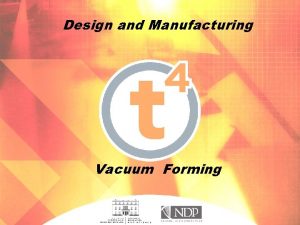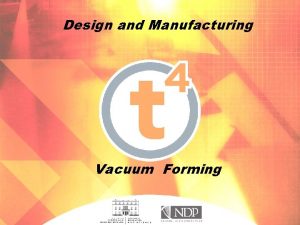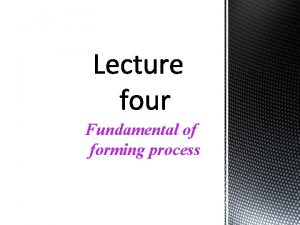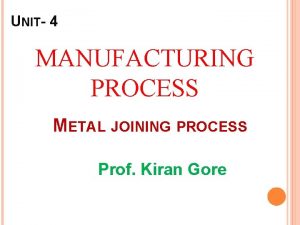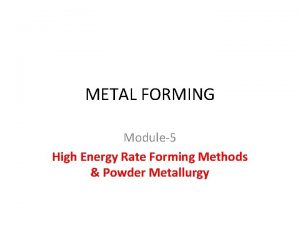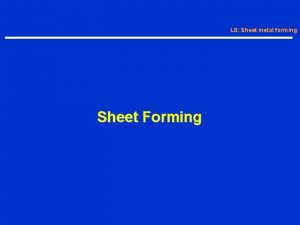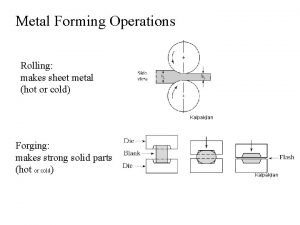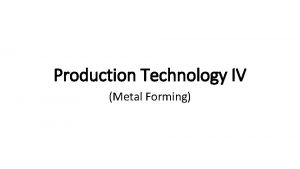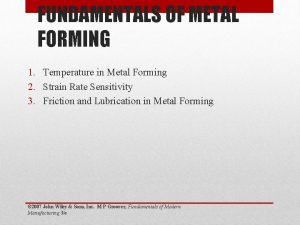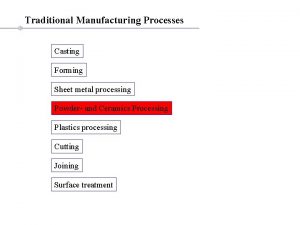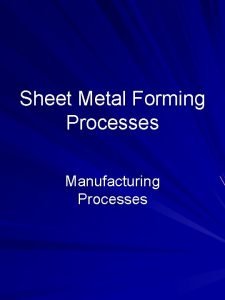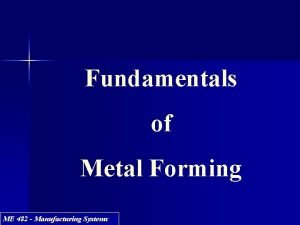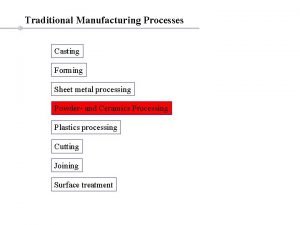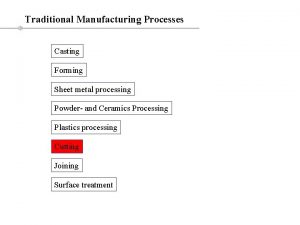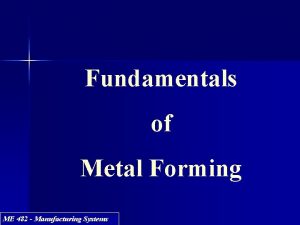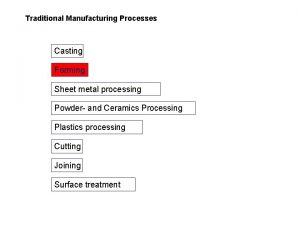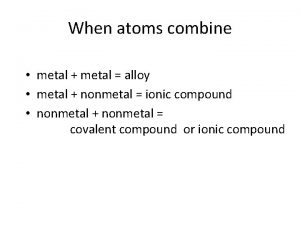UNIT 4 MANUFACTURING PROCESS METAL FORMING PROCESS Prof





























- Slides: 29

UNIT- 4 MANUFACTURING PROCESS METAL FORMING PROCESS Prof. Kiran Gore

METAL FORMING PROCESS TYPES q. Forging q. Rolling q. Extrusion q. Wire drawing q. Deep drawing q. Bending q. A metal in hot or cold condition, is plastically deformed. q No material is removed and wasted but only displaced & deformed in to desired shape

FORGING Is the process in which the metal or alloy is first heated and then plastically deformed to the desired size & shape by the application of compressive force by using hand hammer or a power hammer

WORKING PRINCIPLE OF FORGING PROCESS

F O R G I N G P R E S S

FORGING PROCESS

C R A N K S H A F T

CONNECTING ROD

ROCKER ARMS

GEAR BLANK

LEVERS

AIRCRAFT COMPONENTS

SPARE PARTS

CLASSIFICATION OF FORGING PROCESS Forging (based on working temperature ) Hot forging Or Hot working Cold forging Or Cold working

HOT FORGING In this process the deformation of a material or workpiece in to predetermined shape is carried out at a temperature greater than its recrystallization temperature

HOT FORGING

ADVANTAGES Ø big amount of forming is possible, Ø lower forces required, Ø forming ductility, Ø no of and materials work hardening power are with low

DISADVANTAGES Ø lower Ø accuracy and surface finish, higher production cost, Ø shorter tool life

COLD FORGING AND COLD WORKING Ø In this process the deformation of a material workpiece in predetermined shape carried out at or to is a temperature lower than its recrystallization temperature Ø Usually at room temperature

ADVANTAGES Ø better accuracy, Ø better surface finish, Ø high part, Ø no strength and hardness of the heating is required

DISADVANTAGES Ø higher forces and power, Ø limitations Ø some to the amount of forming, material are not capable of cold working.

CLASSIFICATION OF FORGING PROCESS Forging (based on types of dies) Open die forging process Closed die forging process

OPEN DIE FORGING PROCESS

CLOSED DIE FORGING

CLASSIFICATION OF FORGING PROCESS Forging (based on mode of application of compressive force ) Hand forging process Press forging process

HAND FORGING PROCESS

PRESS FORGING


 Forming process in sheet metal
Forming process in sheet metal Sheet metal adalah
Sheet metal adalah Hot working metal
Hot working metal Draw bead
Draw bead Sheet metal fundamentals
Sheet metal fundamentals Metal forming analysis gtu
Metal forming analysis gtu Advantages of explosive forming
Advantages of explosive forming Mcq on sheet metal forming
Mcq on sheet metal forming Metal forming part
Metal forming part Fundamentals of metal forming
Fundamentals of metal forming Manufacturing cost vs non manufacturing cost
Manufacturing cost vs non manufacturing cost Manufacturing cost vs non manufacturing cost
Manufacturing cost vs non manufacturing cost Non controllable cost
Non controllable cost Manufacturing cost vs non manufacturing cost
Manufacturing cost vs non manufacturing cost Additive manufacturing vs subtractive manufacturing
Additive manufacturing vs subtractive manufacturing Ionic bonding problems
Ionic bonding problems Solid particles diagram
Solid particles diagram Metals and non metals
Metals and non metals Periodic trends acidity
Periodic trends acidity Difference between metal oxides and non metal oxides
Difference between metal oxides and non metal oxides Pimp nimp
Pimp nimp Non metals and uses
Non metals and uses Periodic table pure substances
Periodic table pure substances Ionic compounds have
Ionic compounds have Periodo y grupo
Periodo y grupo Chemical bond def
Chemical bond def Propiedades de los materiales metalicos
Propiedades de los materiales metalicos Examples of non metals
Examples of non metals Existen tres isotopos naturales del potasio 39k 40k y 41k
Existen tres isotopos naturales del potasio 39k 40k y 41k Particulate forming ceramics
Particulate forming ceramics
